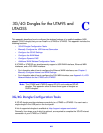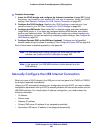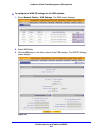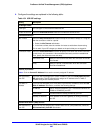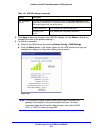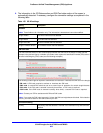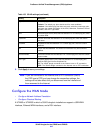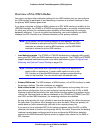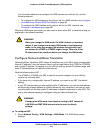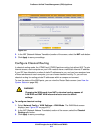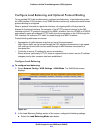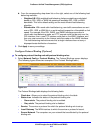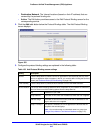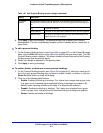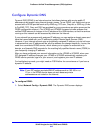
3G/4G Dongles for the UTM9S and UTM25S
611
ProSecure Unified Threat Management (UTM) Appliance
Overview of the WAN Modes
You cannot configure failure detection settings for the USB interface, but you can configure
the USB interface to participate in load balancing or function as a rollover interface in case
the primary WAN interface goes down.
If you have configured an Ethernet WAN interface or a DSL WAN interface in addition to the
USB WAN interface, the UTM9S or UTM25S can be configured on a mutually exclusive basis
for either auto-rollover (for increased system reliability) or load balancing (for maximum
bandwidth efficiency). If you do not select load balancing, you need to specify one WAN
interface (the DSL interface or an Ethernet interface) as the primary interface.
Note: In this section and the following sections of this appendix, the DSL
WAN interface is referred to as the DSL interface, the Ethernet WAN
interfaces are referred to as the WAN interfaces, and the USB WAN
interface is referred to as the USB interface.
• Load balancing mode. The UTM9S or UTM25S distributes the outbound traffic equally
among the DSL, USB, and WAN interfaces that are functional. The UTM9S and UTM25S
support weighted load balancing and round-robin load balancing (see Configure Load
Balancing and Optional Protocol Binding on page 614).
Note: Scenarios could arise when load balancing needs to be bypassed for
certain traffic or applications. If certain traffic needs to travel on the
DSL interface or a specific WAN interface, configure protocol binding
rules for that interface. The rule should match the desired traffic.
• Primary WAN mode. The USB interface, a WAN interface, or the DSL interface) is made
the primary interface. The other interfaces are disabled.
• Auto-rollover mode. You cannot configure the USB interface as the primary link in an
auto-rollover configuration, but you can configure it as the rollover link. A DSL or WAN
interface is defined as the primary link, and another interface needs to be defined as the
rollover link. Because there can be four interfaces on the UTM9S and UTM25S (one DSL,
one USB, and two WAN interfaces), the remaining interfaces are disabled.
As long as the primary link is up, all traffic is sent over the primary link. When the primary
link goes down, the rollover link is brought up to send the traffic. When the primary link
comes back up, traffic automatically rolls back to the original primary link.
If you want to use a redundant ISP link for backup purposes, select the DSL or WAN
interface that needs to function as the primary link for this mode. Ensure that the backup
interface has also been configured and that you configure the WAN failure detection
method on the WAN Advanced Options screen to support auto-rollover for the WAN or
DSL interface.



